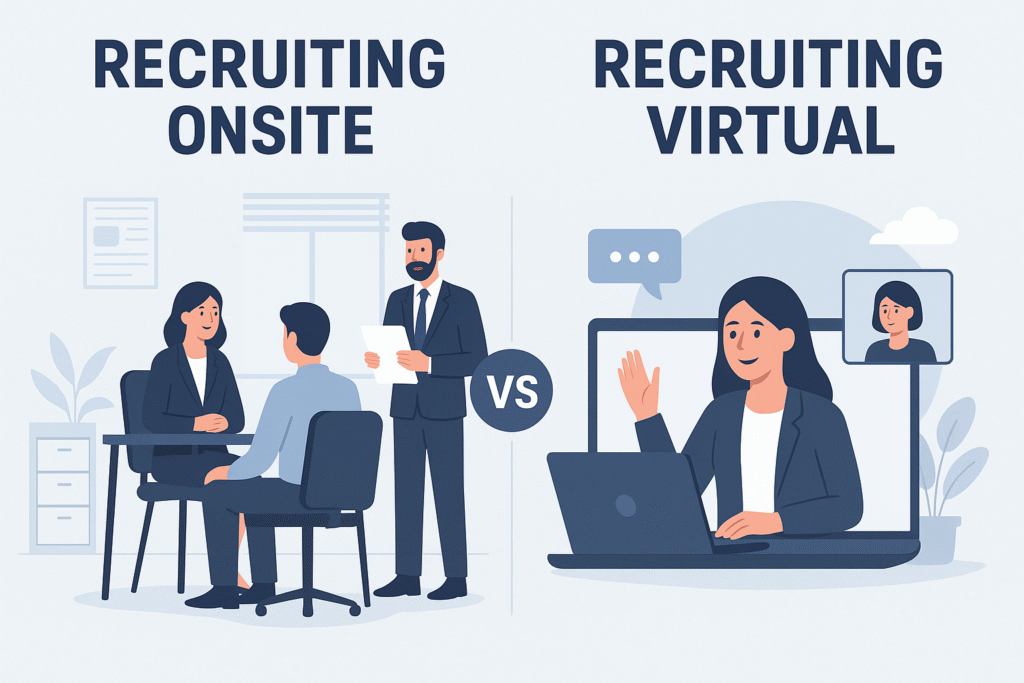In the past, businesses strongly preferred recruiting onsite employees. The logic was simple: teams working under one roof were thought to be more efficient, collaborative, and productive. But as industries evolved and technology advanced, the limitations of onsite recruitment became more apparent.
Today, more and more companies are shifting toward recruiting virtual employees. From accessing a global talent pool to reducing costs, virtual hiring has become a game-changer. In this blog, we’ll compare onsite recruitment vs virtual recruitment, outline the challenges of hiring locally, and highlight why businesses are increasingly embracing virtual teams.

Why Onsite Recruitment Faced Challenges
1. Limited Talent Pool
Local recruitment often restricts businesses to a small pool of professionals. Many companies in regions like Australia and New Zealand experienced stalled growth simply because the right talent wasn’t available in their area.
2. High Hiring & Salary Costs
The cost of acquiring top talent locally kept rising, especially in high-demand industries like IT, software, and digital marketing. Recruiting onsite employees became costly, while equally skilled professionals in countries like India were available at much lower rates.
3. Slower Scaling
Scaling with onsite recruitment meant investing heavily in office space, infrastructure, and training. For startups and small businesses, these costs often slowed down expansion.
The Rise of Virtual Employees
With advancements in technology, virtual employees have become the smarter alternative. Here’s why businesses worldwide are embracing them:
- Global Talent Access – Companies can hire the best professionals from anywhere in the world.
- Cost Savings – Hiring virtual employees eliminates high salaries, real estate costs, and other overheads.
- Collaboration Tools – Platforms like Zoom, Slack, and Asana allow seamless communication, making virtual teams as effective as onsite ones.
- Agility & Upskilling – Virtual employees quickly adapt to new tools and trends, keeping businesses ahead of the competition.
Virtual Employees vs Onsite Employees: A Detailed Comparison
| Factor | Onsite Employees | Virtual Employees |
|---|---|---|
| Talent Availability | Limited to local region | Access to global talent pool |
| Hiring Speed | Often slow and location-dependent | Faster recruitment through remote platforms |
| Cost | High salaries, infrastructure, and perks | Cost-effective with lower overheads |
| Collaboration | In-person, office-based | Digital tools, remote-first collaboration |
| Scalability | Slower, requires infrastructure | Quick and flexible global scaling |
| Innovation | Limited to local expertise | Diverse, global perspectives drive growth |
Why Businesses Prefer Virtual Recruitment
Virtual employees are no longer just a backup option—they are the future of work. Businesses that hire virtual teams gain:
- Faster project delivery through flexible scaling
- Lower operational costs without compromising quality
- Access to niche skills that may not be available locally
- Innovation through global collaboration
From product development to digital marketing, virtual employees are driving growth, efficiency, and innovation in today’s competitive market.
Final Thoughts
The debate of recruiting onsite vs recruiting virtual employees is no longer about tradition—it’s about strategy. While onsite recruitment has its advantages in certain industries, the benefits of hiring virtual employees are undeniable: lower costs, wider talent access, faster scaling, and higher adaptability.
In 2025 and beyond, businesses that embrace virtual recruitment will be better positioned to grow, innovate, and compete globally.
